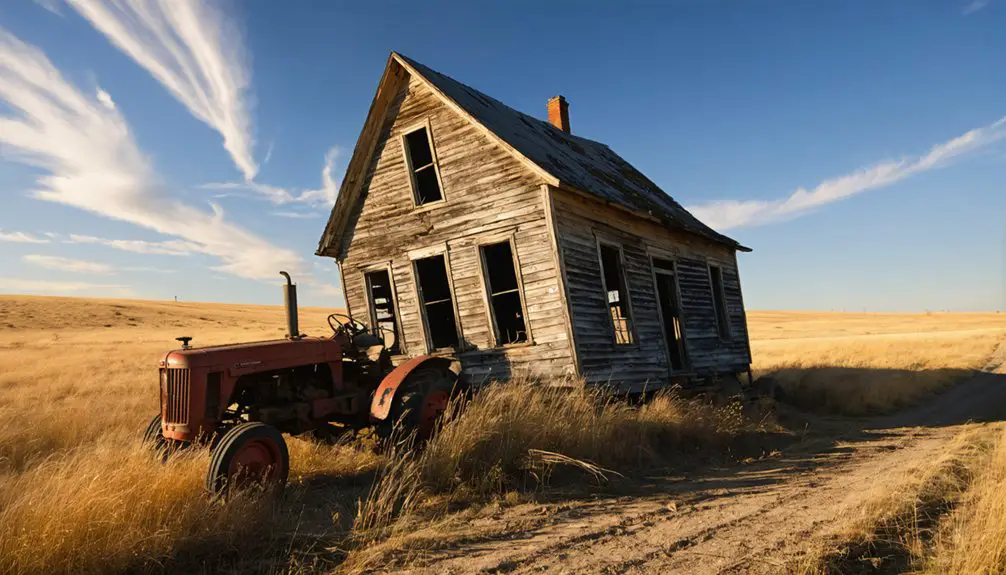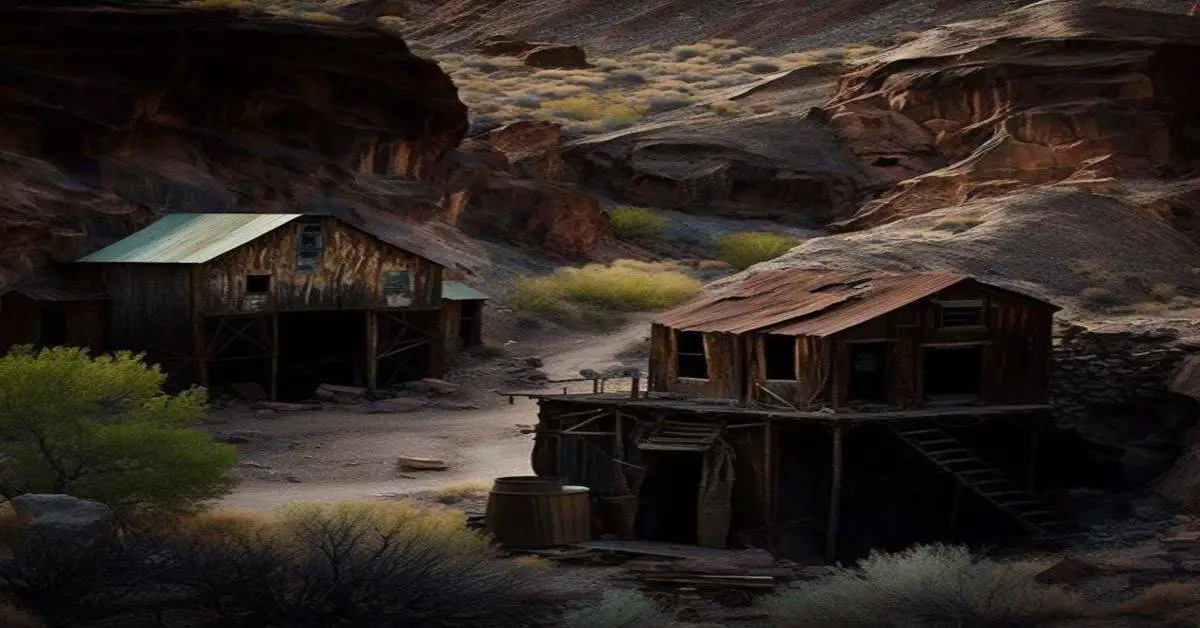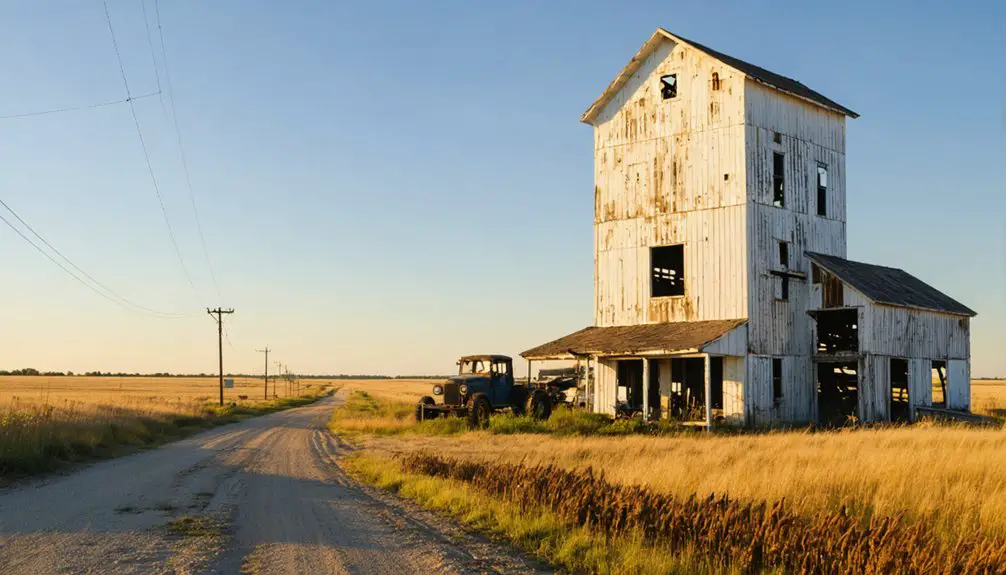You’ll find Petrel, North Dakota established in 1908 along the Chicago, Milwaukee, St. Paul and Pacific Railroad, named for local long-winged pigeons. The town thrived as a strategic rail stop between Lemmon and Haynes, with its post office serving as a crucial communication hub until 1939. Today, only deteriorated foundations remain where this once-bustling railroad community stood. Petrel’s transformation from railway settlement to ghost town mirrors the broader story of America’s changing rural landscape.
Key Takeaways
- Petrel was established in 1908 alongside the Chicago, Milwaukee, St. Paul and Pacific Railroad as a strategic stopping point.
- The town operated a post office from 1908 to 1939, when services were transferred to nearby Lemmon, South Dakota.
- By 2000, Petrel’s population had dwindled to just 28 residents, showing the dramatic decline of this railroad community.
- The site currently contains only deteriorated building foundations, with no remaining visible structures from its railroad town past.
- Located between Lemmon and Haynes, Petrel’s abandonment reflects the broader pattern of Great Plains railroad town decline.
The Rise of a Railroad Settlement
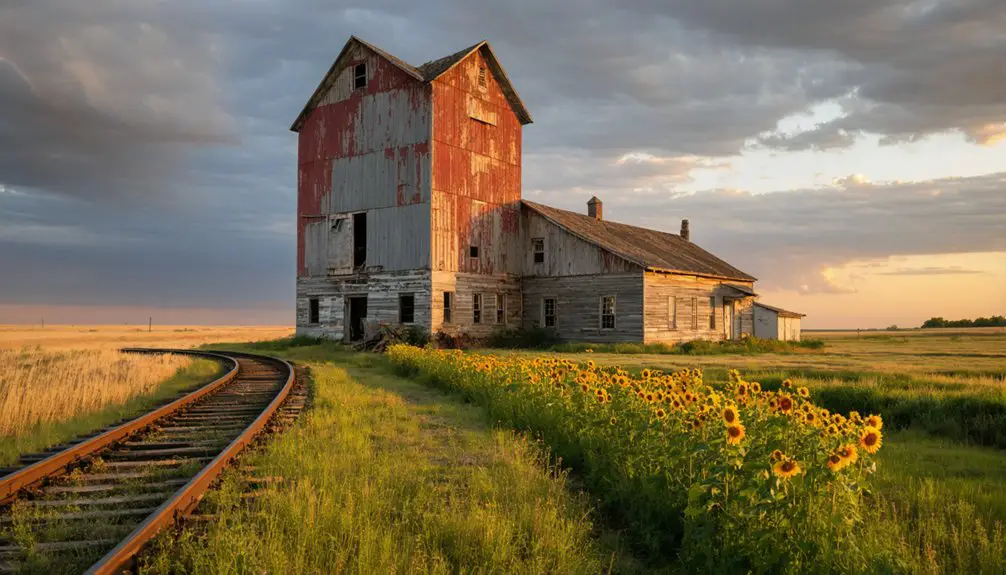
Three key developments marked the establishment of Petrel, North Dakota in 1908: the arrival of the Chicago, Milwaukee, St. Paul and Pacific Railroad; the strategic placement of a railroad siding; and the relocation of a post office from nearby Thebes.
You’ll find Petrel’s origins deeply rooted in the era’s railroad expansion, as it emerged during a time when rail companies actively drove town development across the Dakota Territory.
The settlement’s location just north of the South Dakota border, between Lemmon and Haynes, made it an ideal stopping point for the Milwaukee Road’s operations.
Named for the long-winged pigeons in the area, Petrel focused primarily on transportation and logistics rather than farming or commerce, reflecting the railroad’s dominant influence in shaping new frontier communities.
Life Along the Milwaukee Road
Life along the Milwaukee Road brought dramatic technological and social transformations to communities like Petrel through innovative rail operations and infrastructure development.
You’d see the railroad’s impact firsthand in the pioneering electric locomotives powering through challenging mountain terrain, sometimes exceeding 100 mph on intercity routes. The railroad spurred remarkable economic growth, drawing workers and settlers to previously remote areas while creating thousands of jobs during both construction and operations.
You’d witness the ambitious scope of engineering feats, with crews surveying 5.5 miles for every mile chosen through rugged landscapes. Local communities experienced unprecedented growth, as Idaho’s population doubled from 162,000 to 325,000 in under a decade.
The line’s extensive infrastructure included 21 bridges, 16 tunnels, and 7 high trestles in the Bitterroot Mountains alone, representing the highest construction costs for any Rocky Mountain rail route.
Postal Service and Community Changes
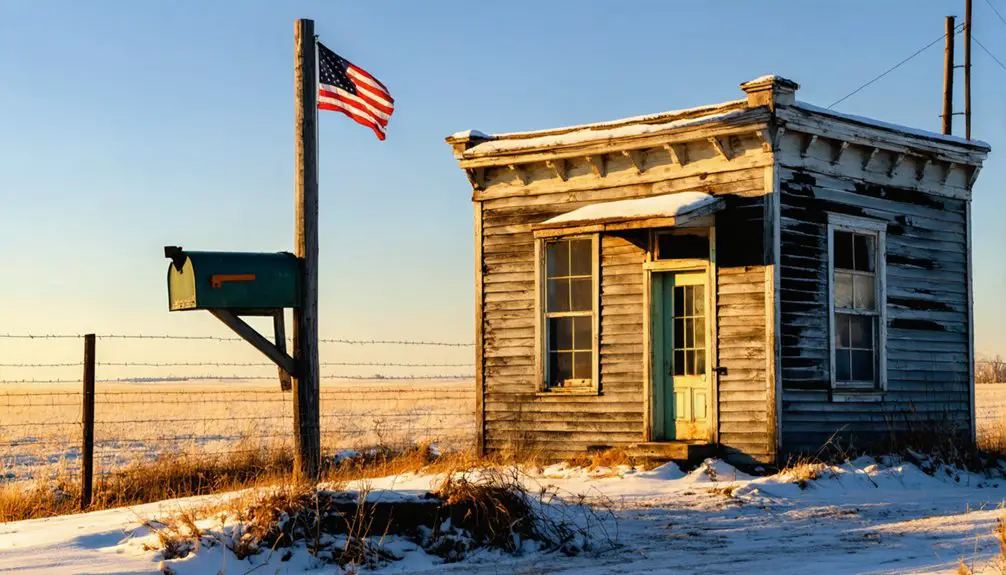
While the Milwaukee Road brought physical connectivity to Petrel, the establishment of its post office on October 29, 1908, marked an essential administrative milestone for the nascent townsite.
You’ll find that this post office, relocated from nearby Thebes, helped forge Petrel’s postal identity within the region’s communication networks.
The office’s closure on September 30, 1939, fundamentally changed Petrel’s rural connectivity, as mail services shifted to Lemmon, South Dakota.
When Petrel’s post office shuttered in 1939, the town’s vital mail connection moved south across state lines to Lemmon.
You can trace this shift in federal records, which show how Petrel began sharing Lemmon’s ZIP code (57638).
This change reflected broader trends across North Dakota, where post offices declined from nearly 2,000 historically to just 295 by 2011.
The loss of Petrel’s postal services likely hastened its transformation into a ghost town.
From Bustling Stop to Abandoned Site
Founded in 1908 along the Chicago, Milwaukee, St. Paul and Pacific Railroad, Petrel emerged as a promising railroad townsite in Adams County, North Dakota.
During the region’s railroad expansion era, the town established itself as a crucial stop between Lemmon, SD and Haynes, ND, even relocating the post office from neighboring Thebes to solidify its position as a community hub. Like many ghost towns in North Dakota, Petrel exists today as an abandoned site with no visible structures remaining. Like many communities in the Great Plains, Petrel’s decline was accelerated by the devastating economic impacts of the Dust Bowl in the 1930s.
- You’ll find evidence of community decline in the loss of the post office by 1939
- Railway operations diminished as highways and trucking gained prominence
- Population dropped to just 28 residents by 2000
- The once-bustling stop now features only deteriorated building foundations
Today, you’ll see Petrel marked as mile marker 909.7 on the BNSF Railway, serving as a silent reminder of how quickly a town’s fortune can change when its primary economic lifeline fades.
Legacy in North Dakota’s History
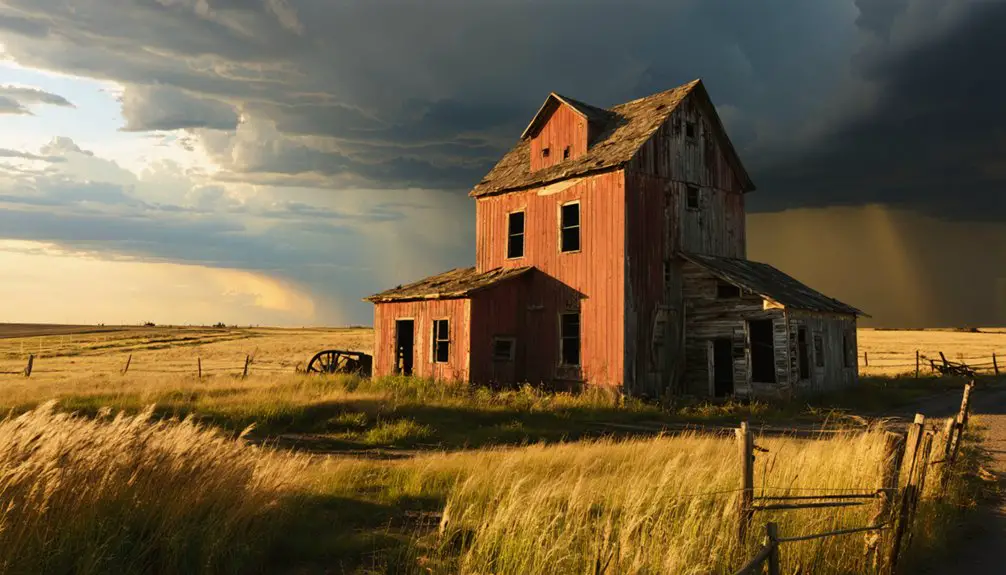
As a tribute to North Dakota’s railroad expansion heritage, Petrel’s legacy extends beyond its physical remains to encompass broader historical patterns of settlement and decline in the American Great Plains.
You’ll find Petrel’s story woven into the fabric of regional development, where the Milwaukee Road’s influence shaped communities and postal networks across state lines.
The town’s ecological significance, reflected in its naming after local long-winged pigeons, demonstrates how early settlers connected with their natural surroundings.
While Petrel’s structures have vanished, its administrative impact persists through the Lemmon, South Dakota ZIP code that serves the area today.
Though Petrel itself no longer stands, its legacy lives on in the postal system, served by neighboring Lemmon, South Dakota.
You can trace Petrel’s evolution from a bustling railroad siding to a ghost town, exemplifying the transformative forces that reshaped North Dakota’s rural landscape throughout the 20th century.
Frequently Asked Questions
What Was the Population of Petrel During Its Peak Years?
Population statistics indicate you’d have found between 100-150 residents during Petrel’s peak years in the mid-1910s, with most historical accounts pointing to 1914 as the period of highest occupancy.
Were There Any Notable Businesses or Industries Besides the Railroad?
You won’t find records of any significant businesses beyond the railroad in Petrel. There’s no evidence of agricultural development or mining operations – the town relied solely on railroad-related services.
How Many Buildings Originally Stood in the Town of Petrel?
You won’t find exact counts of Petrel’s abandoned structures, but historical significance suggests a small cluster of 10-15 buildings, including the post office, railroad facilities, and scattered homes along the siding.
Did Any Significant Historical Events or Disasters Occur in Petrel?
Like a quiet sunset, you won’t find any major disasters in Petrel’s history. The town’s story is simply one of railroad expansion followed by steady community decline as rail importance diminished.
Are There Any Surviving Photographs of Petrel During Its Active Years?
You won’t find readily available historical documentation or archival resources showing Petrel during its active years. While railroad company archives might contain photos, none have been widely published or confirmed.
References
- https://en.wikipedia.org/wiki/Petrel
- https://northernsentry.com/2025/06/26/north-dakota-ghost-towns/
- https://kids.kiddle.co/Petrel
- https://ghostsofnorthdakota892857007.wordpress.com/2017/03/28/the-story-of-how-ghosts-of-north-dakota-began/
- https://www.houseofhighways.com/nearby/usa/midwest/north-dakota/petrel
- https://www.ndstudies.gov/gr4/early-settlement-north-dakota/part-1-early-settlement-north-dakota/section-9-railroads
- https://kids.kiddle.co/Rhame
- https://www.history.nd.gov/ndhistory/settlement.html
- https://www.history.nd.gov/hp/PDFinfo/North-Dakota-Railroads-MPDF-Final-corrected.pdf
- https://www.mpl.org/archives/milwaukee_road_archives.php
